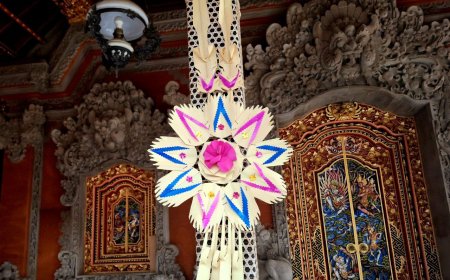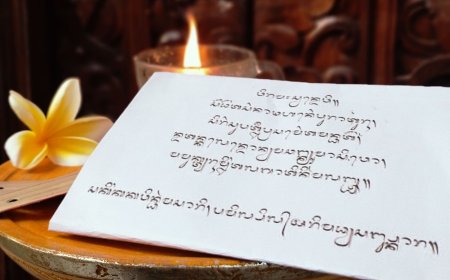Magical and Majestic: The Beauty of the Kecak Dance in Balinese Culture
The magical performing art from Bali, which combines vocal without music and magnificent movements. Created in the 1930s, this dance narrates the epic of Ramayana and captivates the audience with its distinctive vocal sounds of 'cak-cak-cak.' The Kecak dance is a tribute to the gods in religious ceremonies and a major tourist attraction in Bali, supporting the local economy. With its enchanting vocal sounds and beautiful movements, the Kecak dance reflects the cultural richness of Bali and serves as a powerful manifestation of its extraordinary performing arts heritage. The magical beauty and grandeur of the Kecak dance are invaluable cultural assets of Bali.

Bali, the enchanting island with its breathtaking natural beauty, has captivated the world as one of the most famous tourist destinations. Its stunning beaches, sprawling green rice terraces, and captivating ancient temples make it a place full of charm and allure. However, beyond its natural beauty, Bali is also known for its deep and unique cultural heritage. One of the most striking aspects of Balinese culture is its performing arts, with the Kecak Dance being one of the grandest expressions of Bali's culture. This article will explore the magic and grandeur of the Kecak Dance in Balinese culture, revealing its history, significance, and the unforgettable experience it offers to both locals and visitors.
The Kecak Dance, often referred to as the "Monkey Dance," first emerged in the 1930s as a unique form of Balinese dance drama. It was developed by a German artist and musician named Walter Spies, who collaborated with a Balinese dancer named Wayan Limbak. This mesmerizing dance drew inspiration from the Ramayana, one of the oldest and most revered Hindu epics in the world.

The Kecak Dance Performance (Photo Source: Personal Collection)
One of the distinguishing features of the Kecak Dance is its minimal use of musical instruments. The performance entirely relies on the rhythmic vocalization and chanting performed by a large group of male dancers. The word "kecak" itself is derived from the sound "cak-cak-cak" produced by the choir during the performance. Typically, there are between fifty to seventy male dancers who sit in concentric circles around an oil lamp, moving and chanting together while creating a harmonious soundscape.
The Kecak Dance is a visually and aurally captivating art form. The male dancers who perform this dance wear only the iconic checkered Balinese cloth, and they have well-trained bodies. They depict characters from the Ramayana with dynamic and expressive movements.
Throughout the performance, these male dancers create beautiful geometric formations, which are a primary characteristic of the Kecak Dance. They interlock, spin, and move flawlessly, creating mesmerizing and captivating patterns that delight the audience. The precision and uniformity of these movements are among the most impressive aspects of this dance.
Of course, the auditory element is also a crucial part of the Kecak Dance performance. The rhythmic and spirited choir singing creates a magical and profound atmosphere. The distinctive vocals and the continuous rhythm carry the audience into a hypnotic state, immersing them in the unfolding story.
The Kecak Dance is not just a work of art but a part of Balinese culture. It is often performed as part of religious ceremonies and traditional rituals, such as weddings, welcoming important guests, or major celebrations. Additionally, the Kecak Dance is frequently staged to introduce and promote Balinese culture to international tourists.
One of the significant values of the Kecak Dance is its ability to convey moral and spiritual messages through the Ramayana story. The performance blends art, religion, and Hindu philosophy in an entertaining and educational form. Through characters like Rama, Sita, Hanuman, and Ravana, the Kecak Dance illustrates concepts such as virtue, sacrifice, courage, and triumph over evil.
Furthermore, the Kecak Dance plays a crucial role in preserving Bali's cultural heritage. Young generations are encouraged to learn this dance from an early age, ensuring that the knowledge and skills required for this performance are preserved and passed down from one generation to the next. This is part of Bali's commitment to maintaining and nurturing its cultural heritage.
For those visiting Bali, witnessing the Kecak Dance is an unforgettable experience. The performance is often held in many tourist locations across the island, with one of the most famous venues being Pura Uluwatu, an ancient temple located at the southern tip of Bali. The performances here are held at sunset, creating a dramatic backdrop that enriches this experience.
As the performance begins, the audience is immediately entranced by the harmonious vocals and graceful movements of the dancers. They are taken on a spiritual and artistic journey through the epic story of the Ramayana, as if they themselves are part of the narrative.
It is essential to note that the Kecak Dance is a highly interactive performance. At times, the audience may be asked to participate in various parts of the story, adding an element of excitement and greater joy to the watching experience.
The Kecak Dance is one of Bali's most beautiful and valuable cultural heritages. It is an art form that not only entertains but also educates and empowers the community. In all its grandeur, the Kecak Dance reflects the rich and profound soul and identity of Bali. For tourists visiting Bali, witnessing this performance is an incredible way to experience and appreciate this remarkable culture. And for the local residents, the Kecak Dance is a symbol of pride and the strength of their culture, which will continue to be empowered and preserved for future generations. Thus, the beauty of the Kecak Dance will continue to shine brightly in Bali's captivating culture.





























































